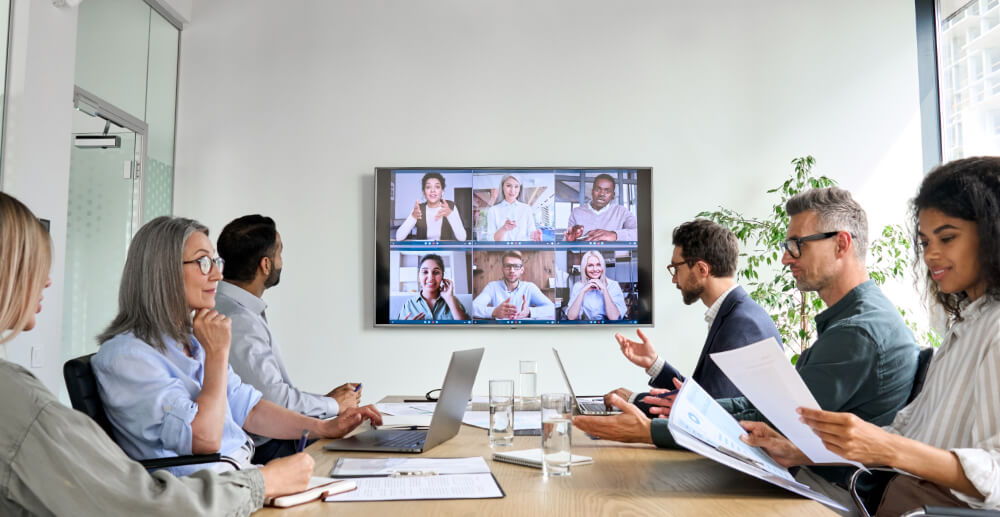Recently, I attended a meeting virtually with six of my colleagues who were gathered in the office. And, thanks to the facilitator, the overall experience was great. However, not all of my colleagues were aware of the adjustments that needed to be made for remote attendees such as myself.
For example, one of my super kind and thoughtful teammates had no idea that I was looking at the back of her sweater for her entire presentation! She was mortified when she later received this feedback from another participant.

To tap into the benefits of hybrid meetings, you need to ensure that both in-person and remote participants feel included, encouraged to participate, and are able to collaborate efficiently.
While it’s important to extend grace and compassion to one another as we all learn to make adjustments for hybrid meetings, if we take the time to consider the experience of in-person and remote attendees, decide what best practices will look like for our organizations, and clearly communicate them to everyone, we might just be able to avoid awkward moments like the one above - and deliver an optimal experience for everyone involved.
Design Your Meeting With Hybrid In Mind
Planning a meeting, especially if your team is global or even spread across the country, can be challenging. We suggest respecting different time zones and finding a meeting time that works for everyone.

We always advocate sharing relevant information before you meet so that both in-person and remote attendees have enough time to review and print out materials before you start.
Thanks to the shift to remote work over the last few years, there’s been an explosion of research on remote and hybrid meetings. For example, researchers have learned that attention spans tend to be shorter for virtual attendees and Zoom fatigue sets in when we spend too much time on camera.
Agree And Train Around Hybrid Meeting Best Practices
Communicate ahead of time the expectations for remote attendees, in-person attendees, presenters and facilitators so that everyone is on the same page.
When establishing hybrid guidelines, consider accessibility and the needs of all attendees. Perhaps that includes more flexibility. You may decide to have some meetings without cameras or give remote attendees the space to go off-camera as needed. Maybe it means building more frequent breaks into the flow of the day, covering less material, or leaving time for connection before the official start time.

Create signs or verbally remind in-person attendees of hybrid best practices. For example, reminding individuals who are sitting close to the microphone (especially if you’re not using a meeting owl or something similar) that their sounds are magnified and something as simple as rustling papers may interfere with remote attendees’ ability to hear what’s being said.
Finally, any exercises or activities you plan (for example, break-out sessions) need to work for both in-person and remote attendees. It can feel lonely and isolating to be left out of a portion of a meeting.
Consider Technology And Room Setup
For a successful hybrid meeting, you want to plan ahead and ensure the room setup and technology enhance the experience for both in-person and remote attendees. Here are our best tips:
- Look for a meeting space for in-person attendees with a large conference table or arrange chairs in a semi-circle so that everyone is spread out for the best audio/video experience.
- Choose a room with a nice big screen so everyone can see the remote attendees.
- Tape off or ring off an area around the video monitor so in-person attendees don’t accidentally knock over the camera.
- Invest in great supporting tech such as the Owl Meeting Pro, which has a 360° camera, mic, and speakers and automatically focuses on the speaker so you don’t have to readjust cameras, etc.; it also integrates nicely with Zoom.
- Record the meeting (with everyone’s consent) or use a transcript service like Otter.ai. If it’s possible and you have the budget for it, hiring a videographer can be beneficial.
Now that you know what to consider, let's move on to the most important part of getting 'meeting ready'...

Complete Test Runs
Arrange to have one or more remote attendees arrive early to check the audio and visual tech with someone attending in person. Make sure remote attendees (or facilitators) can see and hear from different parts of the room. If you’re the one presenting, double-check with remote and in-person attendees that everyone can see and hear you before you begin. Check the audio settings of the meeting software you use before the meeting starts.
By the way, did you know that if the “suppress background noise” filter is set too high remote attendees will hear nothing but silence if the room gets too loud because of break-out groups or other activities? So, it's worth testing everything beforehand.

Create Participation Equity
Ensure that you have some way to capture the thoughts and feelings of every attendee in a way that can be shared. Assign someone to monitor the chat and put remote attendees into break-out groups whenever possible.
Finally, if there are conversations before or after the meeting, consider how you can allow space for remote attendees to participate in that too. That connection time is invaluable and something we are all craving. Everyone wants to feel included, and catching up on what’s happening in our colleagues' lives outside of the office with kids, pets, or hobbies can help build relationships among team members.

Given the current business environment, staffing and budgetary changes, remote participation can be even more attractive. And if we want to do business globally or retain and attract top talent, we need to acknowledge that some form of remote work is here to stay.
Hybrid meetings are now the norm, and developing guidelines and training around best practices for hybrid meetings ensures everyone stays connected, engaged, and on track.
Do you have any additional hybrid meeting best practices? Please share your insights with us on LinkedIn. We'd love to hear from you!
If you’d like help designing or facilitating your next hybrid meeting, please reach out to us.


